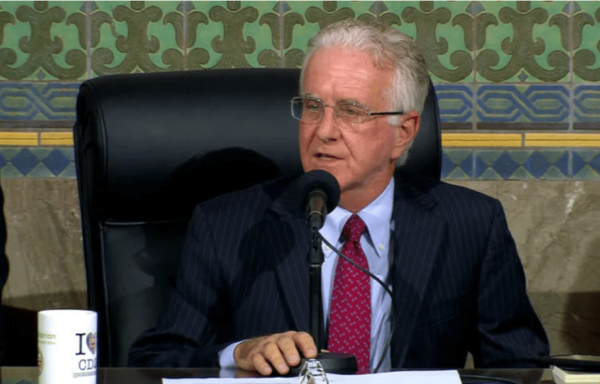The Orange County Board of Supervisors on Tuesday tentatively approved a proposed $9.3 billion budget for the 2023-24 fiscal year, an increase of nearly $475 million from the $8.8 billion 2022-23 spending plan.
The general fund budget, which is the more flexible portion of the spending plan, is $4.9 billion. The rest is primarily spending mandated by law, giving county officials little ability to manipulate.
Most of the discussion at Tuesday’s board meeting, in which supervisors took straw votes on the proposed spending plan, focused on the public safety budget. Multiple residents called on the supervisors to shift more spending from law enforcement to affordable housing, but officials noted that most public safety funding comes from sales taxes earmarked for only law enforcement.
Orange County District Attorney Todd Spitzer said he needed to ask for more money in this year’s budget for more attorneys to handle appeals from convicted killers given a chance to have their cases overturned based on a new state law that redefined murder.
“I’m asking for additional positions because state law has changed dramatically, requiring district attorneys across the state to implement post-conviction reviews,” Spitzer said.
Public Defender Martin Schwarz said his department needs eight positions to work on the post-conviction reviews.
Spitzer defended the county and its work on advancing criminal justice reform.
“The public is not understanding the deep and solid commitment this board has for supporting programs to public protection, which is not just arresting people and putting them in custodial settings and forgetting about them,” Spitzer said. “I am deeply committed to reducing recidivism and helping people.”
Spitzer said he had a “very meaningful conversation” with Supervisor Vince Sarmiento about helping some residents get off gang injunction lists as long as they can demonstrate their “lives are moving in a positive direction.”
Spitzer encouraged county officials to lobby state lawmakers for additional funding to cover the costs of the post-conviction review of cases, which he characterized as an unfunded mandate. He said counties across the state should even consider suing.
Vice Chairman Andrew Do noted that there are 800 mental health beds in its jails and multiple collaborative court programs to help defendants avoid or expunge convictions.
“Ninety-nine percent of the money we are spending in public protection is mandated services by the state — we have no choice,” Do said.
Undersheriff Jeff Hallock told supervisors his department wanted to add funding for nine deputies to work a special unit devoted to helping south county transients connect with services.
Supervisor Katrina Foley said the work was necessary because a federal court settlement prevented deputies from taking transients to shelters outside of south county to the northern or central service areas.
The deputies who work the unit volunteer for it, Hallock said.
“All of the deputies want it, believe it and agree with the philosophy and want to make an impact,” Hallock said.
The budget will be the first since the 2019-20 fiscal year that does not include new state and federal funding related to the COVID-19 pandemic, but officials are still focusing on the build-out of its public health initiatives, stemming largely from efforts to reduce the homeless population.
“With the end of the state and federal emergencies related to COVID-19, the county continues its commitment to public health as it navigates lingering impacts from the pandemic, and the persistently high inflationary pressures placed on the economy,” Orange County CEO Frank Kim said in his annual statement on the recommended budget.
Kim Engelby, the county’s budget and finance director, told City News Service last month when the proposed budget was unveiled that the county expects to complete its spending of American Rescue Plan Act pandemic funding from the federal government by year’s end.
The county’s OC CARES initiative, which links five systems of public health in the county, is a major budgeting priority, Kim said.
Engelby said the county is also looking “to repurpose one section of Juvenile Hall.” Officials want to establish living quarters for some children exiting Juvenile Hall because some cannot return to their family or home, Engelby said.
On Monday Foley told City News Service that she was especially interested in that proposal.
“I’m very excited about that,” she said. “We can do all we can while they’re in the system, give them training in trades or the culinary arts or get them through high school or college, but they have to go back to where they fell into the path of a life of crime we’re just starting all over.”
Officials are also working on a “coordinated reentry system” for adults leaving the county’s jails that will help them get a job or learn a trade to get them back on their feet and cut down recidivism, Engelby said. That is envisioned as a public-private partnership, she added.
Officials have budgeted $76 million for a youth transition center, which includes $25 million for housing, Engelby said.
Another major initiative will be funding for green energy technology and sustainability.
“The county is pursuing various efforts aimed towards environmental sustainability and green technologies,” Kim said in his budget statement.
“As part of these efforts, the county is focusing on reducing its carbon footprint and is developing a Green Infrastructure Plan that focuses on ongoing development of green infrastructure specifications and long-term operation and maintenance plans, which complies with various regulatory requirements and future drought and climate action needs.”
The county’s budgeted general purpose revenue is at $1 billion, $60.9 million more than last year’s budget. That is owed mostly to $63.7 million more expected in property tax revenue.
The county is projecting $432.7 million in revenue provided under terms of the 1993 ballot measure Proposition 172. Of that funding, 80% goes to the sheriff’s department and the rest to the District Attorney’s Office. It represents a 2.5% increase compared to the previous fiscal year.
The county will receive about $2.5 million more from the state under terms of AB 109, the public safety realignment effort approved in 2011 to reduce prison overcrowding.
The county projects adding 23 more jobs in the upcoming budget. Most of those will be for public health initiatives.
Officials are also attempting to brace for a potential recession.
“We do maintain healthy reserves,” Engelby said.
The county has $622 million in reserves, or about two months of operating revenue, and is projected to have $666 million saved up by the end of next fiscal year, she added.







